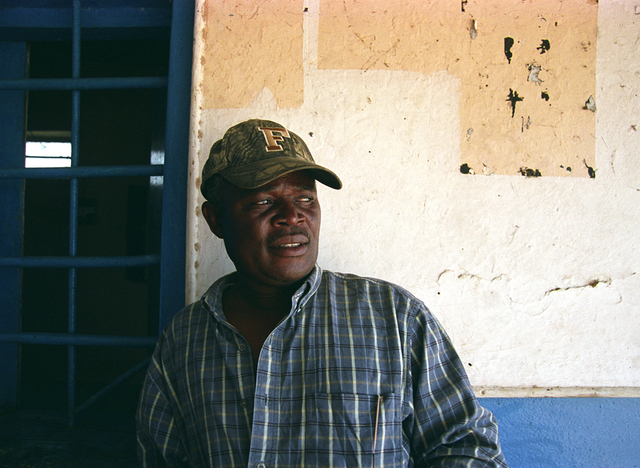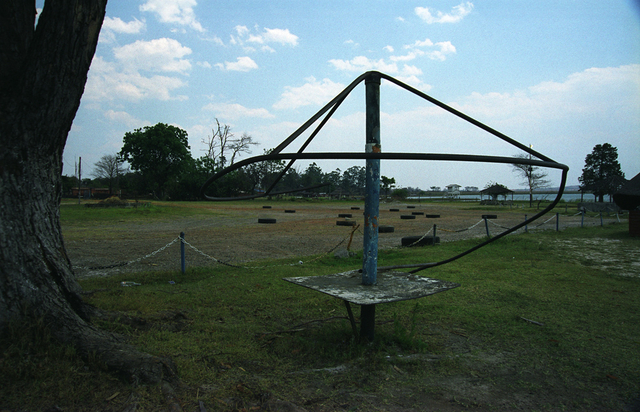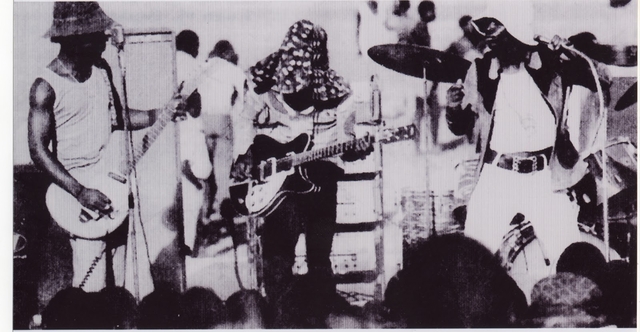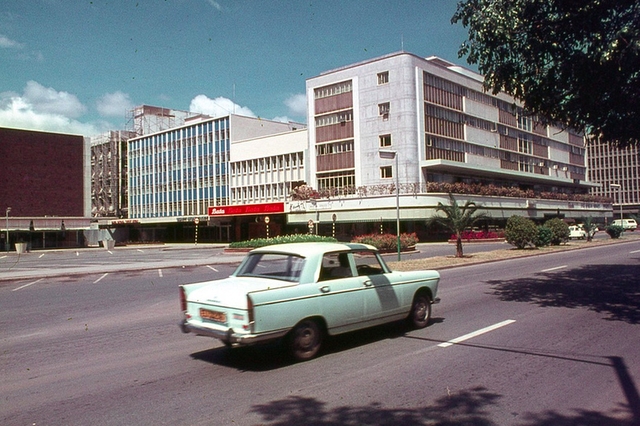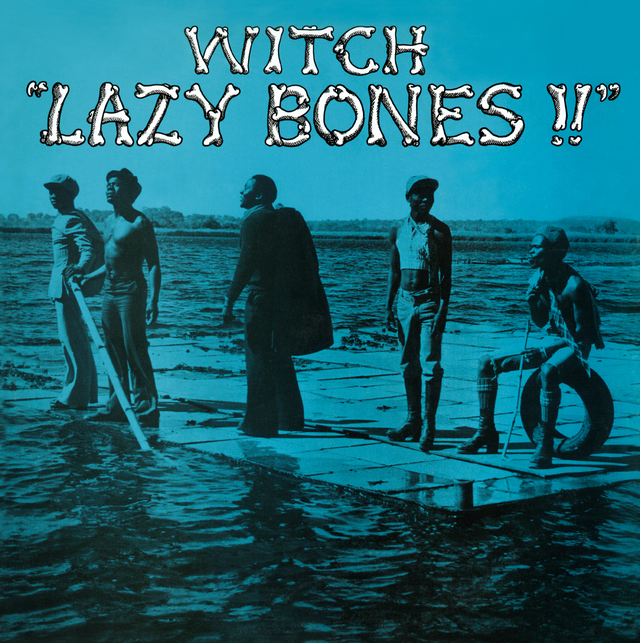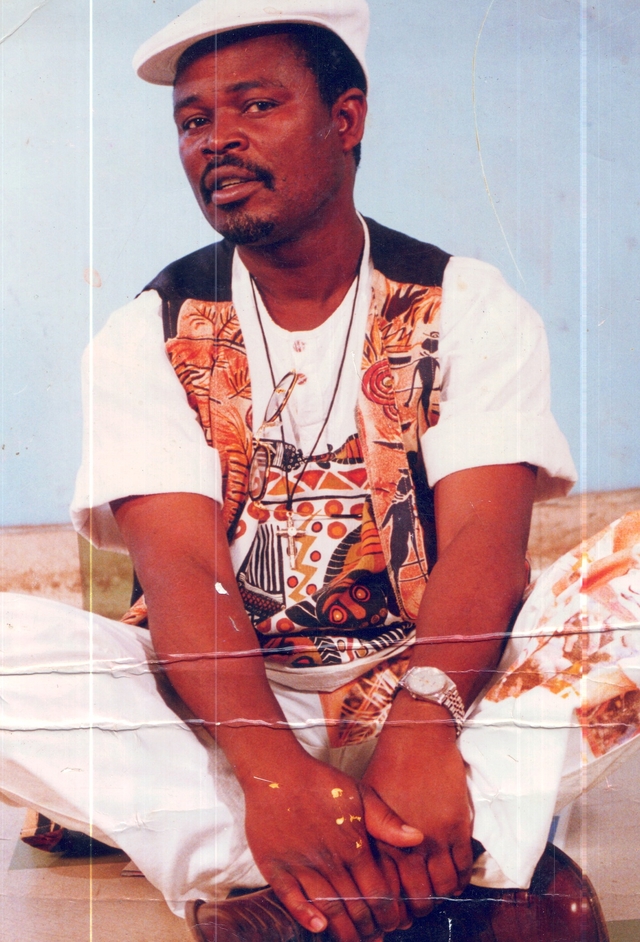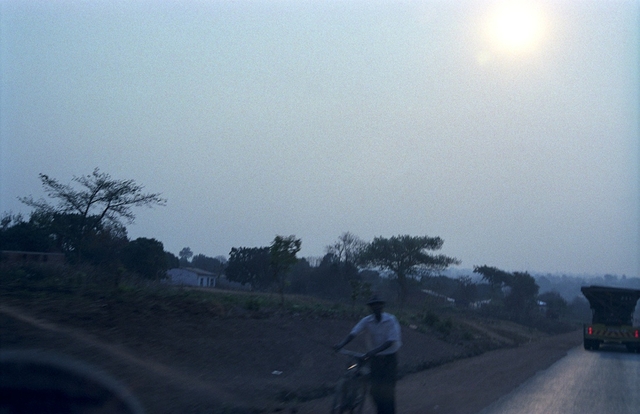We’re a Zambian Band
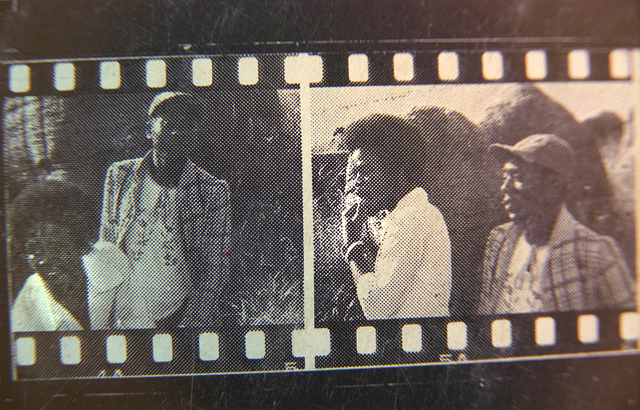
Jagari Chanda (left), vocalist for the Witch, the biggest rock band in Zambia. Photos circa late-1970s.
The drunks at Mindolo Dam rouse themselves at our approach. A teenager in swim trunks and a sun-bleached T-shirt puts down his plastic cup and unlocks the gate. He regards us with bloodshot eyes. “Morning, boss,” he says, angling for a tip.
It’s a Sunday morning in Kitwe, a colonial-era mining town in Zambia’s Copperbelt. Clouds hang low, and the air is hazy. In the countryside, farmers are burning their fields in preparation for the rainy season. We’ve come to this recreation area to see an important part of the country’s musical history.
Emanuel “Jagari” Chanda hops out of a truck. Once upon a time, he was the country’s biggest rock star. As one of the founders of the “Zamrock” psychedelic rock scene of the 1970s, Jagari (an Africanization of Mick Jagger) was a household name. His songs were radio staples, groupies mobbed him, he always drank for free. Now sixty-plus years of age, he’s lost the Afro and gained a few pounds, but he retains a youthful, loose-limbed gait.
The recreation area sits on the edge of a manmade lake, and it’s a gently-ruined place. Jagari strides toward the water, past worn picnic tables and fire pits. Beyond the water lie the copper mines that power this central African country’s economy, open-cut gashes in the earth surrounded by heavily-rutted roads and streams running with mine tailings. Jagari grew up around here. He takes it all in, a dethroned king surveying his lost kingdom. “It’s rundown, as you can see,” he says. “Back then it was new.”
As singer for the Witch, the biggest Zamrock band, Jagari played to packed stadiums and toured across southern Africa. This recreation area was always one of his favorite venues. Often the band played from a stage backed up to the lake. The crowd—miners, soldiers, office workers, students—caught fish, barbecued, drank, and danced. Sometimes the Witch played at night, other times in the afternoon, the show peaking as the sun set over the Copperbelt.
Jagari says, “There was a kind of magic here.”
I first heard the Witch in 2008, via an mp3 blog dedicated to obscure African sounds. The music was incendiary, all crystalline guitar lines and supple rhythms, topped by Jagari’s plaintive voice. The recordings were rife with the pop and hiss of old vinyl; sometimes the music hiccupped, slurring for a moment. This only intensified the thrill of discovery. I found a few more bootlegs online, which confirmed my initial impression: something special went down in Zambia in the 1970s.
At the time, though, reliable information about either the music or the men who made it was hard to come by. How did Zamrock get started in the first place? Sub-Saharan Africa, after all, isn’t really known for its guitar rock. And where were all the musicians now?
Zamrock was the energetic sound of a nation that had just thrown off the British colonial yoke. Though Zambia is now one of the poorest countries in the world, at independence it had the second highest GDP on the continent thanks to its copper industry. Zambians expected great things—prosperity, modernization, and equal standing with the West. With fuzzed-out guitars, propulsive beats, and cosmopolitan outlook, Zamrock provided the soundtrack to this hoped-for future.
That future never arrived. Instead the country was brought low by a series of crises, external and internal, that would render it a ward of the international community by the 1980s. The Zamrock scene, devastated by economic collapse, the AIDS epidemic, and changing musical trends, withered and died.
As for Jagari, I read that he was still alive, but it was hard to say anything else for certain. One report had him working as a foreman at a uranium mine; in another, he was a youth music mentor. A Europe-based musician who had met him emailed me a warning. “Watch out for Jagari,” he wrote. “He can be a bit of a hustler sometimes.” It wasn’t much to go on—from America I couldn’t find a phone number or an email address for him. There was only one way: a friend and I decided to travel to Zambia to track him down.
The man we found, in 2010, had cycled through many lives since his rockstar days. He had been a music teacher, gone to prison for smuggling Quaaludes—a crime he insists he didn’t commit—and found God. Eventually he became a gemstone miner, sleeping in a tent and working an open-pit mine near the Congolese border. A modern-day 49er, Jagari hoped a big score would be his ticket back into the music business.
When we met him, Jagari was unknown outside Zambia, and largely forgotten even in his own country. Since then, improbably enough, he has achieved some of the international fame that eluded him the first time around—a degree of vindication for the lost years.
At the recreation area, we walk down to a weathered dock, the drunk teenager trailing us. As we pose for photos, the kid strips off his shirt and jumps into the dark water. He paddles around self-consciously for a few minutes, as if giving a performance. Jagari ignores him. “It’s like I died and was resurrected,” he says. “That’s how I feel coming here.”
Just before midnight on October 24, 1964, the drummers muted their drumming, the lionskin dancers ceased dancing, and everything went dark. Then, at precisely 12:01 a.m., the Union Jack was lowered and the Zambian flag rose over Independence Stadium in Lusaka, the capital. Fireworks arced through the sky, and the crowd roared. The old order was dead.
Later that day, Kenneth Kaunda, a socialist and former teacher who had canvassed support for the struggle by playing “freedom songs” on his guitar, was sworn in as president. Speaking to a crowd of 200,000, Kaunda acknowledged the sacrifices of those who had fought. Independence hadn’t come bloodlessly—security forces had shot, tortured, and imprisoned hundreds—but there were sunny days ahead. He urged his fellow citizens to “rise and march forward to peace, progress, and human development and dignity.”
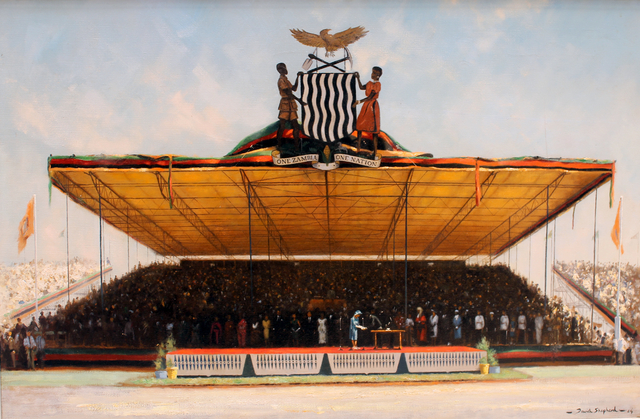
A 1964 painting of the inaugauration of Kenneth Kuanda, first president of post-liberation Zambia, by David Shepherd. Lusaka National Museum
Zambians had reason to feel good about the future. Just three hours before independence, the government had negotiated a more equitable stake in its copper mines—which at the time provided 90 percent of the country’s foreign exchange—with the British company that had owned them since the late 1800s. Kaunda embarked on an ambitious nation-building campaign, constructing schools and training a black African professional class. The need was acute: at independence Zambia had fewer than 100 native-born college graduates.
With the copper profits rolling in, however, nothing seemed out of reach. While Zambia’s rural areas were undeveloped, the New York Times noted in 1964, its main cities were “among the most modern in Africa, with shiny, airy public buildings that many Americans and Europeans might envy.”
The Copperbelt was especially prosperous; as more black Zambians rose through the ranks, miners bought pricey suits, new cars, and Western-style houses. Photos from 1963 show the first black Africans, employees of Roan Antelope mine, in Luanshya, to move into a previously all-white neighborhood. The images carry a whiff of suburbia: housewives pose next to gleaming stoves; a man in shirtsleeves mows his tidy lawn. Simon Zukas, a liberation hero and former Member of Parliament, remembers the euphoria of the time. “There was great optimism,” he says. “The first few years were very good.”
Jagari came of age during this heady era, a member of the first generation of Zambians to grow up more urban than rural. Though born in a northern village, he was raised in the rapidly-growing Copperbelt by a brother who worked as a foreman in the mines. Middle-class by Zambian standards, Jagari attended high school, went to nightclubs as well as traditional township bars, and listened to the latest foreign records at a downtown music store. Indeed, the globalizing forces that brought the ideas of Marx and Fanon to inland Africa also brought the sounds of the British Invasion. To young Zambians like Jagari, the Fender Stratocaster was the sound of modernity.
By the late 1960s there were dozens of rock groups scattered throughout Lusaka and the Copperbelt. Some of these bands just imitated their Western idols, but the best of them mixed the pop sensibilities of the Beatles, the fuzz guitars of Cream, and indigenous kalindula rhythms, creating something distinctly Zambian. There were standard-issue tunes of broken hearts, but other songs displayed a profoundly non-Western take on the world. A band named Amanaz, singing in one of Zambia’s seventy-two different languages, charted the continent’s journey from slavery to independence. Paul Ngozi sang of the nightmares he endured after renting a house next to a graveyard.
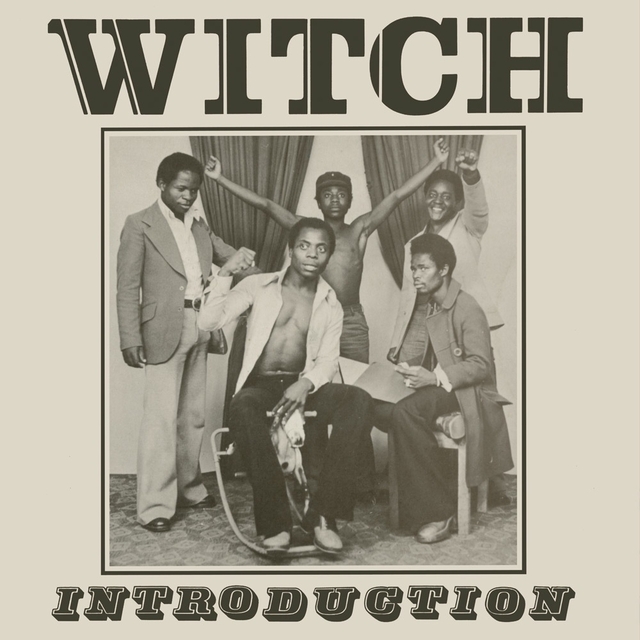
The original cover of the Witch’s first LP, Introduction, released in 1972. Psychedelic Baby Blog
The Witch, an acronym for “We Intend to Cause Havoc,” was the most popular band in the country. Along with another pioneering group, Rikki Ililonga’s Musi-O-Tunya, they forged the path that others would follow. As Eothen Alapatt, who runs Now-Again records in Los Angeles and has reissued a host of Zamrock albums, puts it, the two bands were “the scene godfathers, the inspiration for them all.”
Jagari joined the Witch in 1971, while he was still in high school. His older brother disapproved—“rock star” was no career for an educated Zambian—so he ran away from home. He finished high school but never looked back. The band’s first two albums, with simple-but-catchy songs and one-take production values, were hits. It wasn’t until the third album, 1975’s Lazy Bones, that the Witch hit its stride. Driving and often dark, with melancholy melodies and acid-laced guitar playing, the album sold 7,000 copies its first week—huge numbers for the place and time. Alapatt calls it “a masterpiece—not just of Zamrock, but of psychedelic rock in general.”
The band’s live shows, meanwhile, became the stuff of legend. While the band vamped behind him, Jagari jumped into the crowd from balconies, gyrated like a dervish, screamed or sang as the spirit took him. Shows often went for six hours or more. Typically, they began with an hour of instrumentals followed by a few cover songs—“Sympathy for the Devil,” maybe, or Grand Funk Railroad’s “We’re an American Band.” Jagari modified the lyrics to that one: “We called it ‘We’re a Zambian band.’ People liked it that way.” Some nights, the crowd demanded to hear the band’s hit songs two or three times over.
Soon the Witch was headlining stadiums across the country. Errol Hickey, the former chairperson of Lusaka’s Radio Phoenix, Zambia’s only independent station, says, “Those were the only places that could hold them—they could draw a couple of thousand people, easy.”
“Chifundo” by the Witch, which has more of an “ethno-rock” sound.
In some ways, the Zambian rockers were similar to their Western counterparts. Sporting luxuriant Afros, platform boots and voluminous bellbottoms, Zamrockers defied the prevailing conservative attitudes. Sometimes the Witch went onstage with artfully torn clothing, or women’s underwear over their jeans. Keith Kabwe, who sang for Amanaz and is now a Pentecostal pastor, wore a skeleton costume and jumped out of a coffin onstage, a la Screamin’ Jay Hawkins.
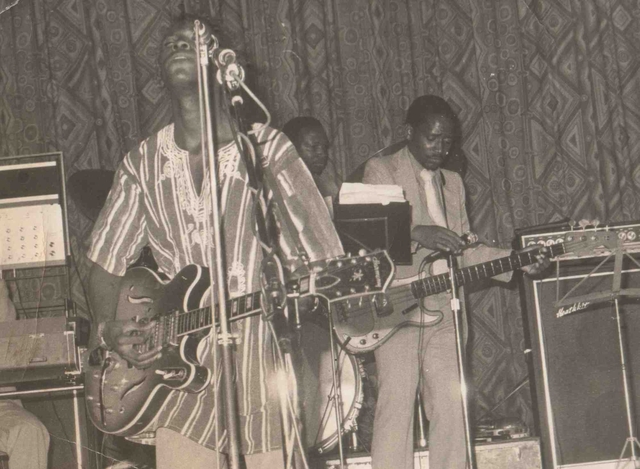
Rikki Ililonga, one of the founders of Zamrock, performing live in the early 1970s. The Cosmic Clash
Such antics occasionally got them into trouble. One October evening in 1974, the Witch was playing a show in a tony Lusaka neighborhood when the police showed up. The Minister of Home Affairs, no rock ‘n’ roll fan, lived nearby. Jagari and his bandmates were charged with “noisemaking to annoyance” and thrown into Kamwala prison for three days.
Alcohol and drugs, meanwhile, were everywhere. Some used speed and acid, but weed was by far the most common drug. Jagari says he drank a bit but otherwise abstained. Others indulged. “We smoked,” Kabwe says, laughing. “We smoked a lot! There was hard stuff here. Once you’d pull it, you’d be seeing things.”
And then there were the women. In Ndola, the administrative capital of the Copperbelt, I meet a teacher who tells me that she grew up going to Witch shows. Her best friend, she adds, once dated Jagari—“he was so crazy.” When I mention the woman to Jagari, he says he doesn’t remember her, but he’s not surprised. “Everybody had groupies.”
Even at the best of times it wasn’t a lucrative life. Instruments were expensive and payment low. A Copperbelt record label, Edward Khuzwayo’s Music Parlour, was known for treating bands fairly, but that was the exception. As Wayne Barnes, who played guitar for Musi-O-Tunya, recalls in an interview with Alapatt, “There were some really shady whites running nearly all the record companies in Africa.”
Still, Jagari got by. The band toured constantly, from Botswana to Kenya—in Malawi, they received a police escort on the way to a concert for the local diplomatic corps. They recorded two more albums of increasing sophistication, which incorporated strong African and Latin elements. The years passed, and Jagari dared to dream of more—London, New York, Los Angeles.
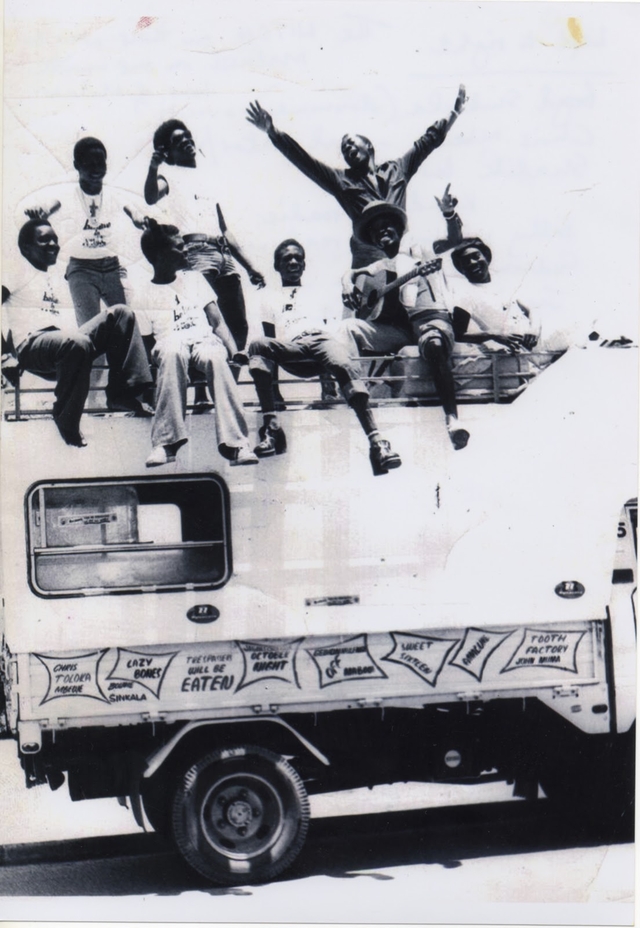
The band’s touring van (seen here in Malawi, in 1975) became famous in its own right. The Lusaka music journalist Felix Nyambe remembers, “If you saw that van, you knew the Witch was in town.” Psychedelic Baby Blog / Jagari Chanda
Zambia’s golden years didn’t last. By the late 1970s the price of copper had plummeted. Inflation spiked, and the mines slashed their workforces. There were lines for bread, shortages of salt. The government had nationalized the mines, and it proved disastrous. To pay off its creditors, Zambia borrowed more. The economic death spiral tightened.
Meanwhile, there was chaos on the borders. Mozambique and Angola were fighting civil wars, and black rebels in Rhodesia, Zambia’s southern twin under colonial rule, were engaged in an insurgency against the white government. Zambia, which sheltered Zimbabwean and South African guerrillas, suffered under curfews and blackouts, its power stations bombed by the apartheid state’s security forces. While Kaunda’s government foiled a coup attempt in 1980, an uprising in the country’s remote northwest simmered for years. Led by an ex-game warden named Adamson Mushala, the rebels burned villages and press-ganged children into service. People said Mushala could render himself invisible, and shape-shift into a giant bird. More credible were the reports of his South African backing.
In response to these pressures, the once-progressive liberation government turned increasingly authoritarian. It wasn’t a dictatorship, exactly, but you had to watch your step. Informers were everywhere. As Hickey puts it, “If you said ‘Kaunda is shit’ you’d go into jail for a few years.”
For the Zamrockers, it was all bad news. The curfew reduced bands to playing “tea-time” shows, which greatly limited their audience. Tastes were changing, too, as disco and Congolese rumba began to supplant rock as the new sound of urban Zambia. Finally, piracy was on the rise; bootleggers copied Zamrock albums in Nairobi then sold them throughout Zambia.
It had never been easy to be a fulltime rock musician in Zambia. Now, with little money to record or tour, it was almost impossible. Jagari bailed out. He had just married his wife, Grace, and they were starting a family. In 1980 he landed a job teaching music at a Lusaka college (He would go on to major in music and English). He spent the next years studying and working to support his growing family.
Jagari was lucky in one respect. He got out just before AIDS decimated the Zamrock community. One by one, his former bandmates succumbed to the virus—the last on Christmas Eve in 2001. “Musicians in Zambia are very careless with life,” says his wife Grace. “Jagari’s not better than the ones who died. He could have been gone as well.”
In 1993, though, things went horribly wrong. Jagari was arrested and charged with trying to pick up a shipment of Mandrax (the southern African name for Quaaludes) from India at the Lusaka airport. He denies having any knowledge of the illegal drugs in the boxes; acquaintances tricked him, he says, into letting them use his ID. “I have never even been to India,” he says. The judge didn’t buy it, and sentenced him to a couple of years in prison.
When he emerged from prison he was broke and pushing 50. He had lost both his job and his home. Gradually, he found a new path. He became a born-again Christian, giving up alcohol and womanizing. As much as he loved making music, it seemed out of the question—he needed money. “Maybe God is saying something to me,” he thought. “Maybe it was my turning point to do other things.”
He became a miner.
Zambia is the size of Texas, with a population of 14 million. As we touched down in Lusaka, the capital, in 2010, we worried that we wouldn’t be able to find Jagari.
We needn’t have. Within a day of our arrival we were sitting across a table from Jagari’s oldest son, Dale, who we had found through a mutual acquaintance. The son of a woman Jagari dated in the 1970s, Dale was an easy-talking 32-year-old who had worked as a traveling salesman, a gemstone miner and seller, and a political campaigner. He hadn’t really known his father as a child; the two reconnected after Dale, then 18, read a newspaper article in which Jagari said, “I don’t know where my son is, but I love him.”
Dale informs us that his dad is “in the bush” at his open-pit mine in Mansa, in the red-dirt highlands along the Congo border. Gemstone mining is a common occupation in Zambia. While the country’s organized mining business is the province of multinationals, tens of thousands of Zambians lease small digging concessions from the government, scratching out a living with shovels and sweat. The area around Mansa is rich in citrine, amethyst, and black tourmaline. Jagari and two Senegalese business partners had been working their plot for about a decade. They hadn’t yet struck it rich. Hope, as they say, springs eternal.
A plan comes together: Jagari will take a minibus to meet us in Kitwe, the Copperbelt city where he grew up. I give Dale money to wire to his dad for bus fare, even though we’re not sure yet if Dale’s for real. He’s already floated the idea of a joint real estate deal; it’s possible that he’s conning us clueless mzungu (“white people”). He speaks movingly, however, of his relationship with Jagari, and of his desire for his father to get the recognition that he deserves.
The next morning, we pile into a rented pickup truck and drive the 200-plus miles to Kitwe. The Copperbelt road, a narrow stretch of tarmac punctuated by small roadside settlements, is mostly empty. There are occasional checkpoints; they provide opportunities, Dale explains, for poorly paid cops to extract bribes from minibus passengers. Every so often, an 18-wheeler carrying oil to the mines appears on the horizon. Other cars pull to the roadside like submissive dogs, huddled against the force of the rig’s passage.
We meet Jagari at an upscale miner’s bar that evening. Dressed in a leather bomber jacket and a baseball cap, he looks more like a suburban dad than a rock star. But the magnetism that once captivated audiences seems to be intact. He flirts with the waitress, a sly smile on his face, and as the DJ plays auto-tuned hip hop he recounts his life story. A group of younger Zambian guys gathers at the other end of the table. They haven’t heard of him, but one guy leans in, listening raptly. He yells over the music: “Respect!”
A few days later I meet Jagari in downtown Lusaka, a sprawling city that makes up for in friendliness what it lacks in organization. He arrives in an old Japanese car, wearing an oversize white tunic and matching pants. Markers of the gemstone business are strewn about the car. A bag of citrines sits in the console between the seats; he has an appointment later to get them cut and polished. We drive around, listening to the Hollies.
The sidewalk outside the public library is crowded with men doing gemstone deals, coming together to negotiate and then breaking apart to mutter into their cellphones. Some of the stones were mined legally; some certainly were not. Overall, Zambia’s economy is booming, buoyed by the mines and Chinese investment. Apartment blocks and mega-malls are rising all across Lusaka, but there are few new jobs. Sixty-four percent of Zambians still live below the poverty line; more than 80 percent work in the “informal” economy.
I ask Jagari about the Witch’s legacy. He reminisces about the time they opened a show for British-Ghanaian Afro-rockers Osibisa. With more ambition and business savvy, he muses, perhaps the Witch could have gone international—a Zambian Osibisa. But they were too comfortable being big fish in a small pond. “We never took the risks.”
While he plays occasional oldies gigs, Jagari still dreams of getting back into music full-time. If he can find the money, he’d like to open a music school and a recording studio. “That’s why I go into the bush to look for stones.”
At noon, we take the elevator up to the eleventh floor at Radio Phoenix. Errol Hickey, the station’s former chairperson, has arranged for us to appear on a national radio show. As Jagari tunes his guitar, the host, a young guy named Luchi, tells me that he hadn’t heard the Witch until now.
On-air, Jagari plays a few Witch classics. His voice is raspy, weathered by the years. Near the end, he launches into a song called “It’s Alright.” It’s a love song, but today it ends up sounding more like a statement of defiance.
Excerpt of our interview and Jagari’s performance.
Oh, my baby, I never thought you’d come back my way.
All this time, I’ve been waiting for you to come back my way.
But baby it’s alright.
Baby, it’s alright.
Listeners call in to speak to Jagari. One says he saw him perform at Mindolo Dam. Another asks about a comeback: when will he start playing out again? “Give me kwacha [the Zambian unit of currency], man, to organize the shows,” Jagari replies. “And I’ll be there.”
I left Zambia the next day. Back home in San Francisco, I wrote a couple of articles about Zamrock and kept in occasional touch with Jagari. I never expected to see him again; Lusaka is a long way from California.
Over the next few years, though, Jagari’s star began to rise. Ben Phiri, a journalist from Ndola who has written more than 70 columns on Zamrock for the Times of Zambia, says that young Zambians are “slowly awakening” to their rock ‘n’ roll heritage. “They marvel when they listen to Zamrock. They think Zambians could not have done that.”
Meanwhile, Alapatt’s Los Angeles record label, Now-Again, kept pumping out Zamrock reissues. In 2011, he arranged for Jagari to speak at a music conference in Madrid. The following year, Jagari played two well-received shows in France with fellow Zamrock survivor Rikki Ililonga. There was a Chinese documentary film, and a South African one is due for release this year. Bit by bit, Jagari’s profile grew. I was happy for him: at long last he was getting some of the recognition that had escaped him in his youth.
Then, one morning last spring, I woke to the news that he was coming to America.
The first Zamrock concert in North America takes place in Los Angeles in May 2013, and is followed by another in San Francisco in June. For both shows Jagari is backed by a crack group of LA jazz-funk musicians. Billed as “Zamrock Live!” the LA show is a private concert at a Hollywood art space. The crowd is small but appreciative, and it is wonderful and a little surreal to see Jagari on an American stage, roughly 10,000 miles from where I last saw him. We embrace like old friends after the show.
In San Francisco, Jagari opens for the indie beatmaker and DJ Madlib, and the nightclub is packed. Most of the crowd probably doesn’t know who he is, but they go nuts anyway. In response, Jagari turns back the clock. He jumps and screams, flirts and teases, runs in place like Mick Jagger and duckwalks like Chuck Berry. The closer, “October Night”—a song about the band’s 1974 arrest for playing too loud—sprawls into a nine-minute, Latin-infused space jam. He exits the stage, and it feels like a triumph.
Backstage, Jagari chats with fans, still flush with adrenaline. I ask Alapatt if there are more shows in the works. He shakes his head. “This is it, man,” he says. “I don’t know how to get him back over here.” A number of African bands, of course, tour America regularly. The Malian desert-blues band Tinariwen, for example, whose members wear turbans and cultivate a sort of revolutionary chic, come through California just about every year. Jagari’s music and image, though, isn’t nearly so exotic—he mostly sings in English, and mostly plays a recognizable form of rock ‘n’ roll. Discussing it later, Alapatt says, “Perhaps that just doesn’t fit with the modern booker’s idea of what music from this part of the world ‘should’ sound like.”
Jagari makes the most of his time here. He records some new songs, two of which Alapatt releases as a single: a 1960s-style pop number and a haunting adaptation of a traditional Zambian song about witchcraft. I spend some time playing tour guide in both cities. We eat burritos and drive out to the ocean, watch the surfers and take photos, debate the meaning of life and whether or not the members of Black Sabbath were Satanists (he says yes; I say no). He is philosophical about his late resurgence. “I had hoped for this much earlier,” he says. “But that’s the human point of view. God saw it differently. He was grooming me for the challenge.”
Jagari’s new song “Kwamununga.”
On his last night in America, Jagari comes over to the apartment I share with my girlfriend. Grabbing my acoustic guitar, he gives us an impromptu lesson. Eyes shining, sweat beading on his forehead, he leans into the instrument, working the strings and singing in a soulful growl. “You should practice each skill until it is automatic,” he says, his fingers moving nimbly up and down the frets. He smiles and adds, “Then you are prepared for anything.”


